Mastering the B2B Sales and Marketing Funnel
October 1, 2025
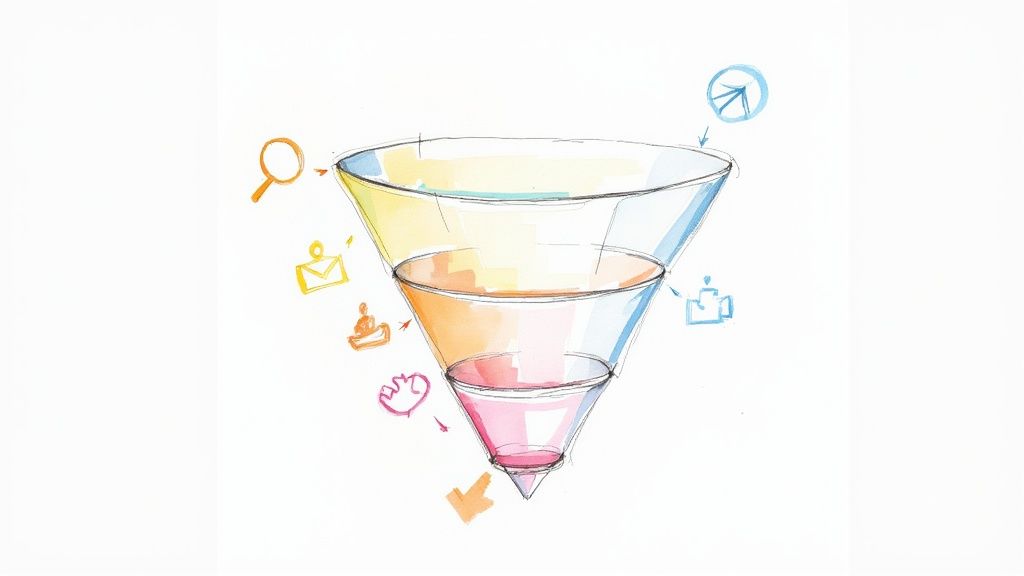
What exactly is a B2B sales and marketing funnel? At its core, it’s a strategic framework that maps out the entire customer journey, starting from the very first flicker of awareness all the way through to the final purchase—and well beyond.
It’s a structured approach designed to attract potential business clients, cultivate their interest, and carefully guide them through what is often a complex decision-making process. By creating this predictable path, businesses can better understand and anticipate customer behavior, turning complete strangers into loyal, long-term partners.
What Is a B2B Sales and Marketing Funnel?
Before we go any further, let's get one thing straight: forget the idea of some rigid, mechanical process. It's much more helpful to think of a B2B funnel as the blueprint for building strong, valuable business relationships. It’s a strategic map that guides potential clients from a place of initial curiosity to a confident, well-informed purchase.
This brings a much-needed sense of predictability to the B2B buying cycle, which, as we know, can be long and winding.
It’s less of a simple sales tactic and more of a holistic system where your marketing and sales teams have to work together effectively. Marketing's job is to cast a wide net, attract potential good-fit companies, and educate them. From there, the sales team steps in to engage the most qualified prospects and close the deal.
This visual gives a great sense of how different marketing efforts feed into the wide top of the funnel during that critical first stage.
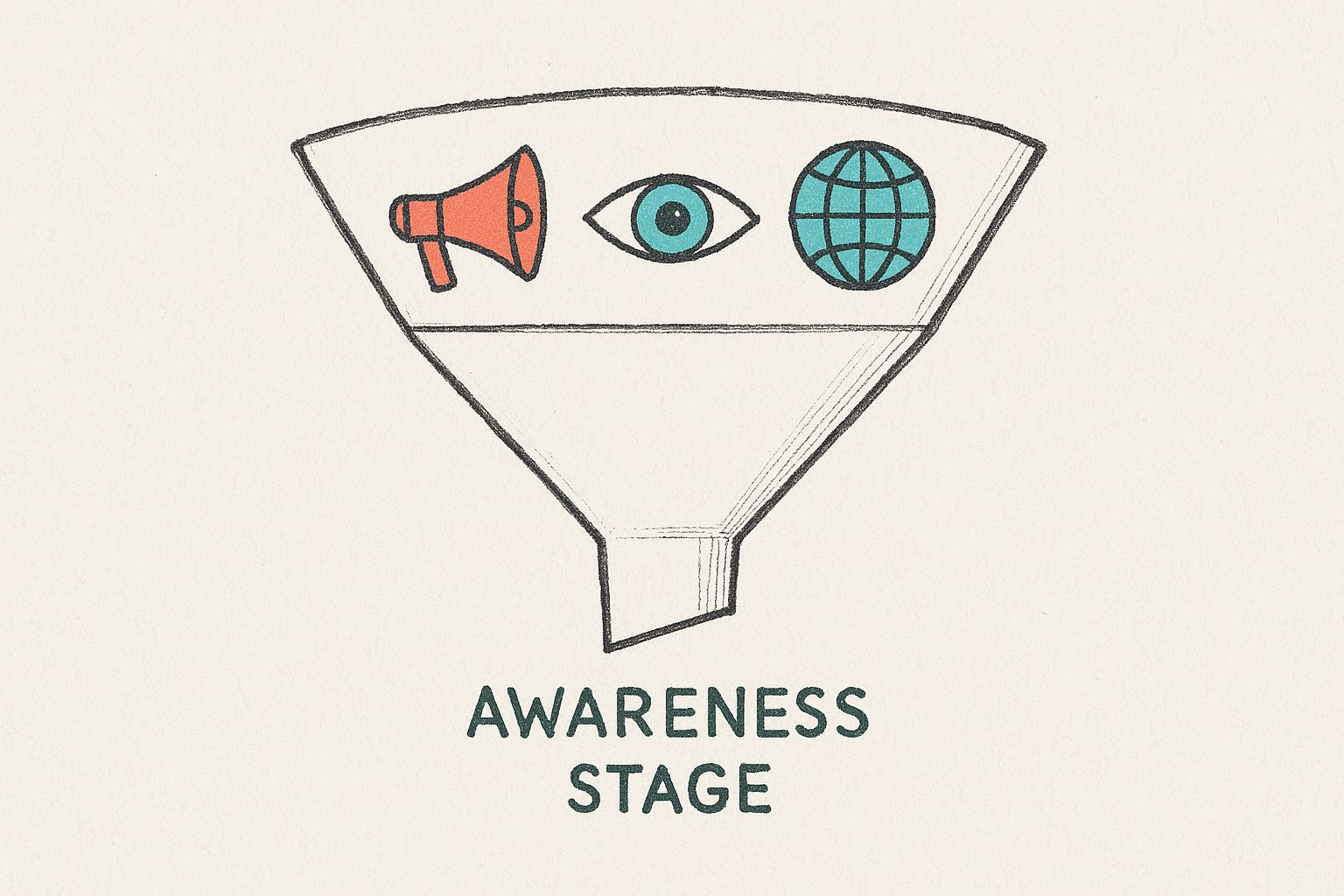
As the image shows, awareness isn't just one action. It’s a combination of outreach, content, and brand presence all working together to capture that initial attention.
The Purpose of a Structured Funnel
Having a well-defined funnel transforms your customer acquisition from a bunch of random activities into a coordinated, measurable growth engine. It provides a clear framework for every single interaction, making sure that each piece of content, every email, and every sales call serves a specific purpose at exactly the right time. For a deeper look at this, our guide on mastering the customer journey in B2B is a great next step.
A solid structure allows you to:
- Generate qualified leads consistently by attracting businesses that genuinely need your solution.
- Align marketing and sales efforts so they're working together seamlessly, creating a smooth, professional experience for every prospect.
- Forecast revenue more accurately by understanding the conversion rates at each stage of the buyer’s journey.
A great B2B funnel doesn't just process leads; it builds trust. Each stage is an opportunity to demonstrate expertise, solve a problem, and prove that you are the right partner for their long-term success.
To give you a bird's-eye view, the table below breaks down the key stages of the funnel. It’s a quick snapshot of the entire journey before we dive into each stage in more detail.
The B2B Funnel Stages at a Glance
This table summarizes each phase of the journey, outlining its main goal and the typical activities you'll see from both marketing and sales teams.
Think of this as your roadmap. Each stage has a distinct job to do, moving potential customers smoothly from one phase to the next.
Understanding the Modern B2B Buyer
The B2B buyer’s playbook has been completely rewritten. Not too long ago, sales teams held all the cards, guiding prospects through a controlled, linear process. Those days are over.
Today’s B2B buyers are more like detectives than prospects. They’re researchers and investigators, arming themselves with a mountain of information long before they even think about talking to a salesperson.
This shift to digital self-service changes everything. Your sales and marketing funnel can no longer afford to wait for a handshake or a phone call. It has to meet buyers where they are right now—online, digging for answers on their own terms. A powerful digital presence, fueled by genuinely helpful content, is now the front door to your business.
This isn’t just a new challenge; it's a massive opportunity for businesses ready to adapt.
The Rise of the Self-Informed Buyer
The journey a modern B2B buyer takes is rarely a straight line. Instead of being led, they’re in complete control, consuming content when and where they want. They’re reading blog posts, downloading white papers, watching webinars, and scanning peer reviews to become experts on their own problems.
This behavior is shaking the very foundation of the traditional B2B sales funnel. In fact, it's projected that by 2025, an incredible 80% of B2B sales interactions will happen in digital channels. On top of that, 72% of B2B buyers kick off their entire process with a simple Google search.
What does this all mean for your funnel? It has to be digital-first, content-heavy, and built to answer questions before a prospect even knows to ask them.
Your marketing isn't just generating leads anymore. It's now responsible for the initial qualification, education, and trust-building that sales conversations used to handle. In many ways, your content is the first—and most important—salesperson a prospect will ever meet.
Building a Funnel for the Digital-First Era
To win in this new environment, your funnel must be designed for self-directed research. This requires getting crystal clear on who your buyers are, what keeps them up at night, and exactly what information they need at each stage of their journey.
This is where a detailed picture of your ideal customer becomes non-negotiable. Building out robust buyer profiles helps you map their journey and align your content with precision. If you're looking to dial this in, our guide on using buyer personas to accelerate B2B marketing and sales is the perfect place to start.
A modern, effective funnel is built on a few key pillars:
- Valuable Educational Content: Forget the hard sell. Your goal is to offer resources that help buyers truly understand their problems. Think in-depth guides, original research, and insightful articles that position you as the go-to authority.
- A Seamless Digital Experience: Your website and landing pages have to be dead simple to find and use. A clunky, frustrating experience will send a self-educating buyer straight to your competitor without a second thought.
- AI-Enhanced Personalization: Technology now allows you to deliver the right message to the right person at just the right moment. AI tools can analyze behavior to serve up relevant content, personalizing the journey for every single prospect, automatically.
Think about it from their perspective. A CTO researching cybersecurity solutions doesn’t want a sales pitch—they want a white paper that breaks down different threat detection technologies. A winning funnel anticipates this need, delivers that exact resource, and builds the credibility needed to earn a real conversation. This is how you turn a simple process into a powerful engine for building relationships and driving real, sustainable growth.
Fueling Your Funnel with High-Quality Leads
A B2B sales and marketing funnel is a powerful engine for growth, but it sputters and stalls without the right fuel. That fuel is a steady stream of high-quality leads. It's all too easy to get caught up in the numbers game, celebrating a high volume of new contacts, but the real win is attracting the right prospects from the very beginning.
When you start prioritizing quality over quantity, you kick off a powerful chain reaction. Every stage of your funnel becomes more efficient, your sales conversations are far more productive, and your entire customer acquisition process starts to build serious momentum. This is where the art and science of modern B2B lead generation truly shine.
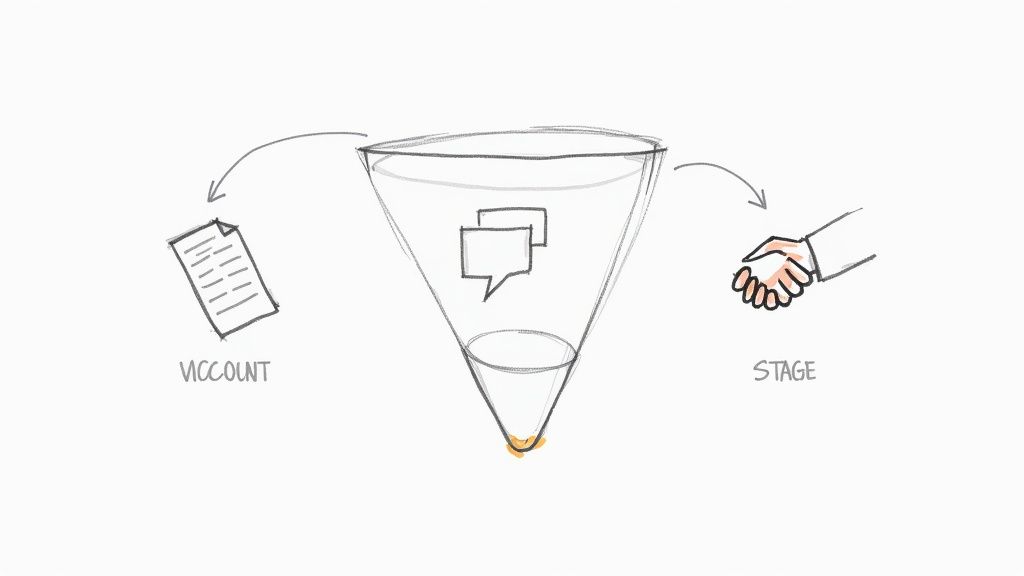
Attracting Your Ideal Customers
The first job in fueling your funnel is to become a magnet for your ideal customers. This is about shifting away from old-school, interruptive tactics and moving toward a strategy of genuine attraction. So, how do you do it? By creating truly helpful content that speaks directly to the specific pain points and daily challenges your target audience is trying to solve.
This approach transforms your brand from a vendor into a trusted advisor. Instead of chasing leads, you build a resource they actively seek out.
For B2B companies, a few key channels consistently deliver high-quality prospects:
- Content Marketing: Developing in-depth blog posts, whitepapers, and guides that solve real-world problems instantly positions you as an authority.
- Search Engine Optimization (SEO): Making sure your valuable content shows up right when potential customers are actively searching for answers is non-negotiable.
- Targeted Social Media: Engaging with professionals on platforms like LinkedIn, where business conversations are already happening, puts you right in the flow of your industry.
The whole point is to provide so much value upfront that getting in touch with your sales team feels like the obvious, logical next step for an informed prospect.
Prioritizing Lead Quality
Shifting your focus to lead quality isn't just a good idea; it's a strategic imperative. A staggering 85% of B2B companies see lead generation and the crucial process of qualifying those leads as their single most important marketing goal. It's so vital, in fact, that around 53% of marketers pour more than half of their entire budget into these activities.
This intense focus isn't just about making the sales team's job easier—it's about building a healthier, more predictable business. A pipeline filled with well-qualified opportunities leads directly to shorter sales cycles, higher close rates, and, ultimately, more revenue.
Attracting a high volume of unqualified leads is like pouring water into a leaky bucket. Focusing on quality plugs the holes, ensuring the effort you put in at the top of the funnel translates into real results at the bottom.
Modernizing Your Lead Generation Efforts
The playbook for finding and attracting B2B leads is constantly evolving. Your strategy needs to keep pace, incorporating more sophisticated approaches that boost both efficiency and effectiveness.
Today, many businesses are looking beyond traditional methods. The future of finding top-tier leads increasingly involves advanced solutions like AI for B2B lead generation, which can identify and qualify prospects with remarkable accuracy. This allows your team to focus their energy where it will have the greatest impact.
Of course, a great lead generation strategy doesn't just stop when a contact form is filled out. It needs to connect seamlessly with the next stages of the B2B sales and marketing funnel, ensuring a smooth and professional handoff from marketing to sales. For a comprehensive look at this process, check out our guide on effective B2B lead generation.
By thoughtfully selecting your channels, creating insightful content, and zeroing in on the right prospects, you build a powerful and sustainable system. This is how you stop just filling a pipeline and start fueling a true growth engine with genuinely promising opportunities.
Optimizing Each Stage for Maximum Conversion
Think of your B2B sales and marketing funnel less like a static blueprint and more like a dynamic engine that needs constant fine-tuning. Small, strategic adjustments at each stage don’t just create tiny improvements—they compound. The result? Significant gains in both revenue and customer acquisition.
The key is to treat optimization as a continuous process, not a one-time project. Turning a prospect’s initial curiosity into a firm decision requires a practical playbook. From the very first click on your landing page to the final handshake on a deal, every interaction is a chance to build confidence and guide them smoothly toward a solution. It's all about building momentum, one conversion at a time.
Fine-Tuning the Top and Middle of the Funnel
At the top of the funnel (TOFU), your main goal is straightforward: turn anonymous website visitors into known leads. This moment of truth usually happens on a landing page where someone trades their contact info for a valuable piece of content, like a whitepaper or a webinar seat.
Getting this right is a science. Your most powerful tool here is A/B testing. Don't guess—test. Systematically experiment with different headlines, calls-to-action (CTAs), form lengths, and images to discover what truly clicks with your audience. You’d be surprised how a simple change, like altering a button’s color or rewording a headline, can dramatically boost sign-ups.
Once those leads slide into the middle of the funnel (MOFU), personalization becomes absolutely critical. They're no longer just browsing; they are now actively evaluating you and your competitors.
- Segmented Email Nurturing: Ditch the one-size-fits-all email blasts. Segment your leads based on their industry, job role, or the content they’ve already downloaded. Then, send them targeted case studies and articles that speak directly to their specific challenges.
- Compelling Case Studies: Nothing is more persuasive than a success story from a company just like theirs. Showcasing concrete data and relatable results provides the social proof they need to start trusting you.
- Interactive Demos and Webinars: This is your chance to show, not just tell. Offer live or on-demand sessions that go beyond listing features to demonstrate tangible business outcomes. Help prospects truly visualize how your solution would fit into their day-to-day operations.
Mastering the Bottom of the Funnel and the Handoff
The bottom of the funnel (BOFU) is where the magic of sales and marketing alignment really happens. This is the moment a Marketing Qualified Lead (MQL) gets passed to sales, becoming a Sales Qualified Lead (SQL). A seamless handoff here is essential to keep the momentum going.
The MQL to SQL handoff should be treated as a moment of strategic collaboration, not a simple transaction. When marketing provides sales with deep context on a lead's interests and activities, the sales team can initiate a far more relevant and effective conversation, preventing valuable opportunities from getting lost.
At this final stage, the conversation shifts from broad education to specific validation. Your prospects need those last few assurances before they sign on the dotted line. This is where having a well-defined B2B sales process becomes indispensable. If you need to sharpen yours, our detailed guide on the B2B sales process provides a step-by-step framework to get it right.
Personalized follow-ups, crystal-clear pricing, and straightforward negotiation terms are what remove the final barriers to a decision.
Across all industries, the average sales funnel conversion rate hovers around 2.35%. However, high-performing businesses can more than double that, achieving rates over 5.31%. That massive gap highlights the immense potential for improvement, though as of 2025, only 34% of companies are actively optimizing their funnels. To explore more about these industry benchmarks, you can discover more insights about marketing funnel conversion statistics on Amra & Elma.
Ultimately, optimizing your B2B sales and marketing funnel is the single most powerful way to close that gap and join the ranks of high-growth companies.
Measuring the Health of Your Funnel
If you can’t measure it, you can’t improve it. That’s an old saying, but it’s the absolute truth when it comes to your funnel. A powerful B2B sales and marketing machine isn’t built on guesswork—it’s engineered with data and fine-tuned with precision. To really steer your business toward predictable growth, you have to look past the vanity numbers and zero in on the key performance indicators (KPIs) that tell you what’s actually happening under the hood.
Think of these metrics as the dials and gauges on your control panel. They don’t just tell you what’s happening; they tell you why it's happening. Learning to read this data is what separates businesses that just react to the market from those that shape their own success. It’s about turning raw numbers into a clear story about your performance.
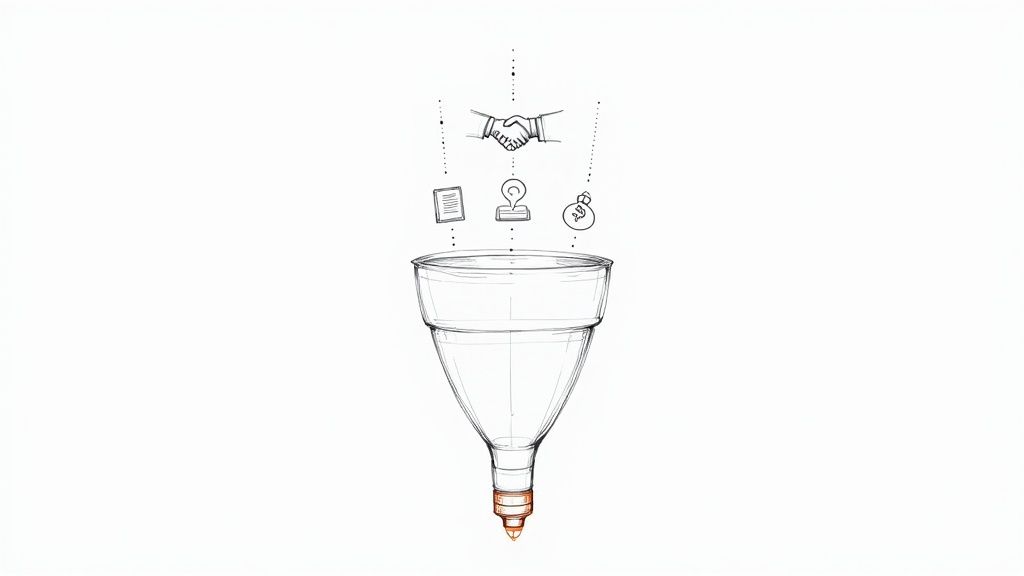
Core Metrics That Tell the Real Story
While there are dozens of data points you could track, a few core metrics give you the clearest picture of your funnel's health. They work together, painting a complete picture that starts with lead flow and ends with long-term profitability. These are your funnel's vital signs.
Focusing here will help you spot trouble early, make smarter decisions, and build a customer acquisition model that can truly scale.
Lead Velocity Rate (LVR): This metric tracks the month-over-month growth in your qualified leads. LVR is a fantastic leading indicator of future revenue—if it’s consistently climbing, you can be pretty confident your sales pipeline will look healthier next quarter.
MQL-to-SQL Conversion Rate: This is the percentage of marketing-qualified leads (MQLs) that your sales team accepts as sales-qualified leads (SQLs). A low number here is a classic red flag. It almost always points to a misalignment between your marketing and sales teams on what a "good lead" actually looks like.
Connecting Funnel Health to Business Growth
Beyond just tracking leads, you need metrics that tie directly to your bottom line. These two KPIs bridge the gap between your marketing activities and financial outcomes, revealing the true efficiency of your entire funnel. They answer the most important questions: Are we spending our money wisely? And are we bringing in the right kind of customers?
That’s where Customer Acquisition Cost (CAC) and Customer Lifetime Value (CLV) come in.
- CAC measures the total cost to acquire a new customer, bundling up all your marketing and sales expenses.
- CLV projects the total revenue a single customer is expected to generate over their entire relationship with your company.
The ultimate goal is to keep these two in a healthy balance, where your CLV is significantly higher than your CAC—ideally by a factor of three or more. This proves you aren't just acquiring customers; you're building a profitable, sustainable business.
A high CAC might mean you're overspending on ads at the top of the funnel. A low CLV could signal problems with your product or onboarding process at the bottom. By looking at these two metrics together, you can make strategic tweaks to your entire B2B sales and marketing funnel.
Now, let's break down the most important metrics to keep an eye on. This isn't an exhaustive list, but it's the dashboard you should be checking daily to understand the health and momentum of your funnel.
Tracking these numbers gives you a powerful diagnostic tool. You can see exactly where things are working and, more importantly, where they're breaking down.
For anyone who wants to go even deeper, exploring a full framework for B2B marketing analytics for growth will give you the tools to build a truly data-driven strategy. By consistently monitoring these vital signs, you can stop reacting to problems and start proactively optimizing your funnel, turning it into a reliable engine for scaling your business.
Building Your Funnel from the Ground Up
Alright, we’ve covered the theory. We’ve dissected the modern B2B funnel, explored why it matters, and looked at how the pieces fit together. Now it’s time to roll up our sleeves and actually build this thing.
Let’s be clear: this isn’t about chasing some mythical, perfect funnel from day one. It’s about laying the first few, solid bricks for what will become a powerful, predictable customer acquisition engine. The process might look intimidating from the outside, but it really just breaks down into a few manageable steps.
Focus on one stage at a time, and you’ll turn this concept into a dynamic system that consistently brings in business. The only place to start is with the most important piece of the entire puzzle: your customer.
Define Your Ideal Customer and Map Their Journey
Before you can build a path, you need to know who you're building it for and where they're trying to go. The very first step is to get brutally honest and specific about your Ideal Customer Profile (ICP). This isn't some vague sketch of a potential buyer; it's a detailed portrait of the exact type of company that gets the most possible value from what you sell.
Once you know who you're targeting, you have to map out their journey. Think from their perspective. What questions are they typing into Google? What information do they need to feel confident enough to take the next step?
- Awareness: What’s the initial pain point that sends them searching for answers online?
- Consideration: How are they weighing their options and comparing different solutions?
- Decision: What are the final proof points they need to see before they’ll sign on the dotted line?
Mapping this journey reveals the exact content and touchpoints you need. It ensures every single piece of your strategy—every blog post, every email, every demo—serves a real purpose.
A well-built B2B sales and marketing funnel doesn't just sell; it serves. By anticipating your ideal customer's needs at every step, you build the trust and authority required to become their obvious choice.
Select Your Tools and Content Strategy
With a clear customer journey mapped out, you can finally choose the right tools for the job and plan the content that will fuel each stage. This is where your strategy gets real. You don't need a dozen complicated platforms to get started.
Begin with a few essentials that will help you automate tasks and see what’s actually working:
- CRM System: Your central hub for tracking every lead and every single interaction. No more guessing games.
- Marketing Automation Platform: The engine for nurturing leads with targeted, relevant email sequences.
- Analytics Tools: Your dashboard for measuring what’s driving results and what’s falling flat.
Next, you need to match specific content to each stage of the funnel. An executive at the top of the funnel might be interested in a high-level industry report, while someone in the middle needs a detailed case study to see how it works. At the bottom? They're looking for a clear pricing guide or an ROI calculator.
For a deeper dive into the nuts and bolts of putting this all together, there are some great resources on how to build sales funnels that actually convert. This approach turns your funnel from a theoretical model into an actionable plan, empowering you to take control and build a system for long-term success.
Have Questions? Let's Talk Through Them.
Even with the best-laid plans, B2B funnels have a knack for throwing curveballs. It’s one thing to understand the theory, but it’s another to deal with the real-world messiness that can make or break your success.
This is a space for the practical questions that pop up when you're in the trenches. Let's tackle some of the most common ones I hear from founders and marketers.
How Long Should a B2B Sales Cycle Actually Be?
There’s no magic number here. The length of a B2B sales cycle can swing wildly depending on what you’re selling. Key factors include your product's complexity, its price point, and just how many people need to sign off on the purchase.
For a straightforward, lower-cost SaaS tool, you might see deals close in 30-60 days. But for complex, enterprise-level solutions that demand a hefty investment and serious integration work, a sales cycle of 6-12 months—or even longer—is perfectly normal.
The goal isn't to artificially shorten your cycle. It's to master each stage within your typical timeframe so you can guide prospects through it smoothly.
What’s the Best Way to Handle Leads Who Go Quiet?
Ah, the dreaded stalled lead. It's one of the most common frustrations, but a quiet lead is rarely a lost one. The first step is to play detective and figure out why they've gone dark. Are they stuck waiting for budget approval? Are they secretly unsure if your solution is the right fix for their specific problem?
Don't just give up and mark them as "closed-lost." A lead that's gone quiet is often just stuck. Your job is to help them get unstuck. Re-engage with something genuinely useful, not just another "checking in" email.
Sending a case study from their industry or an invite to a small, specialized webinar can often be the spark that gets the conversation going again. It shows you’re still invested in helping them solve their problem, not just pushing for a signature.
How Do I Disqualify a Lead Without Burning a Bridge?
Knowing when to walk away is just as important as knowing when to push. Disqualifying a lead is a healthy, necessary part of keeping your pipeline focused on real opportunities. The key is to do it with respect and professionalism.
If you realize a prospect isn’t a good fit—whether it's due to budget, timing, or their core needs—be direct but helpful.
You can politely explain why you don't think it's the right match at this time. If you can, offer a helpful alternative resource or even point them toward a different type of solution that might be a better fit. This approach leaves the door wide open for future business and positions your brand as an honest, valuable resource, not just another vendor trying to make a sale.
Ready to build a B2B sales and marketing funnel that drives real revenue and adoption? At Big Moves Marketing, I specialize in helping B2B SaaS and AI startups implement the positioning, sales tools, and launch strategies needed to win. Let's build your growth engine together.
%20-%20Alternate.svg)

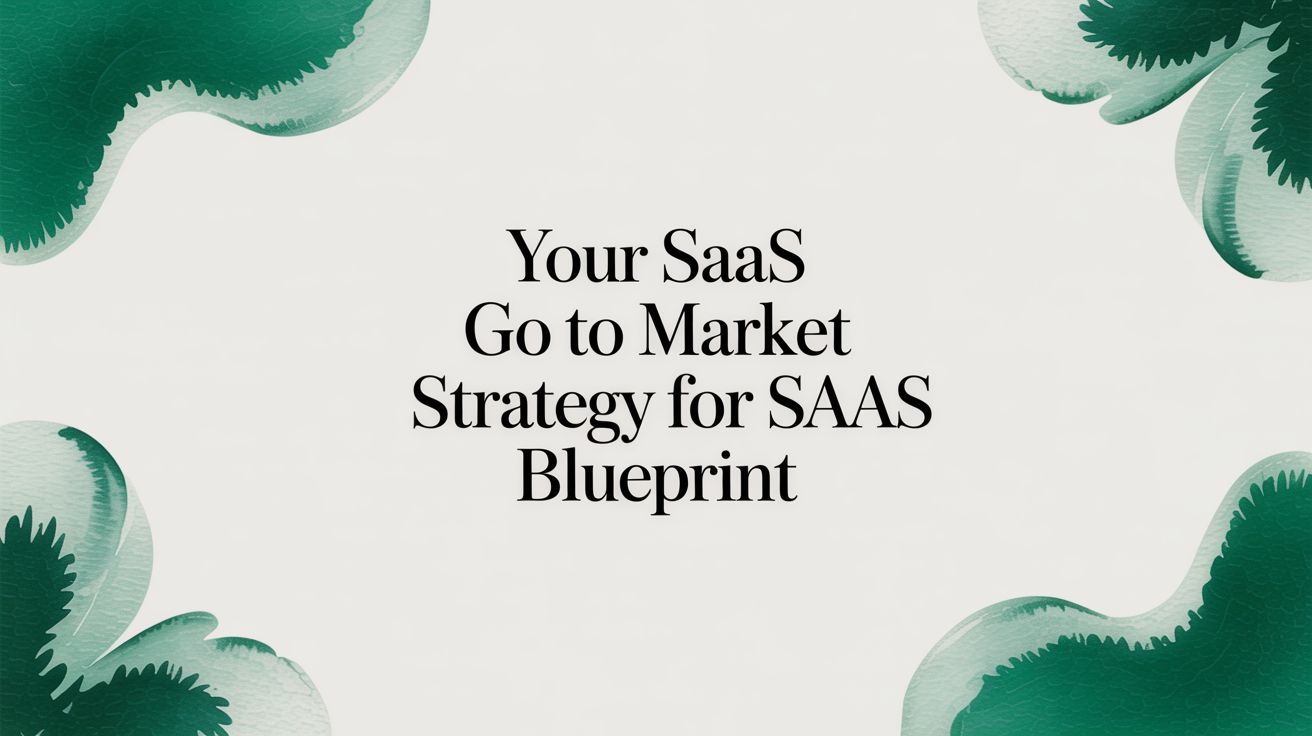
%20-%20white.svg)